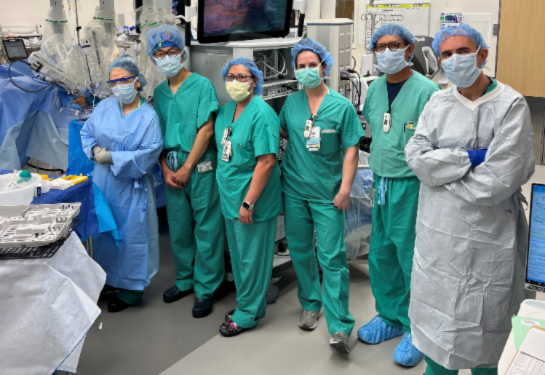UC Davis Health performs first robotic nephrectomy on living kidney donor
Robotic procedure makes kidney donation less invasive than ever
UC Davis Health transplant surgeons have performed the first fully robotic nephrectomy on a living donor in the Sacramento region.
A living donor nephrectomy is a surgical procedure to remove a healthy kidney from one person for transplant into someone else whose kidneys no longer function properly.
Transplant surgery is one of 14 specialties in which UC Davis Medical Center offers minimally invasive, robotic-assisted technology.
“The application of these next-generation technologies underscores our commitment to innovation and excellence in patient care,” said Bahareh Nejad, medical director of Robotic Surgery. “The institutional support we have received to grow the UC Davis Robotics Program has allowed us to provide novel approaches to patient care leading to more minimally invasive surgeries. I look forward to pushing the envelope of patient care and supporting further expansion of our robotic surgery program.”
Advances in kidney transplantation
The robotic living donor nephrectomy surgery was carried out using the latest Intuitive Surgical Robotic System that has small robotic arms that imitate natural dexterity. The robotic arm was controlled by a team of surgeons from a console which enabled the removal of the donor kidney through small incisions.
“The robotic arm’s instrumentation offers a greater range of motion than the human wrist with efficient and precise action,” said Junichiro Sageshima, surgical director of the living donor kidney transplant program, who performed the procedure. “This provides us with easier access to areas that are hard to reach and better visualization.”
Traditionally, living donor nephrectomies have been performed using either a laparoscopic technique or open surgery. Robotic-assisted procedures enable smaller incisions to perform the transplant, which often leads to a quicker recovery with less pain and scarring than a traditional surgery.
“The advantage of this approach lies in its safety as the smaller incisions, combined with greater precision, help reduce pain and scarring, which ultimately leads to rapid recovery, less hospitalization, and a faster return to normal life,” Sageshima added.
Transplant center growth
The robotic living donor nephrectomy program is a multidisciplinary collaboration. It includes operating room staff, nurses, the transplant and robotic surgery teams and leadership, who provided the necessary tools and facility space to deliver the best care possible.
“This new procedure positions the UC Davis transplant program for continued growth and advancement in the services it provides and the quality of care it delivers,” said Sophoclis Alexopoulos, chief of the Division of Transplant Surgery. “This expanded use of robotic tools in transplantation is an example of our faculty's ongoing mission to introduce new techniques to enhance patient care and safety.”
Moving forward, kidney removal or nephrectomy procedures, will be done using robotic and laparoscopic techniques, depending on the availability of robotic systems.
For more information on living kidney donation, visit the UC Davis Transplant Center website.




